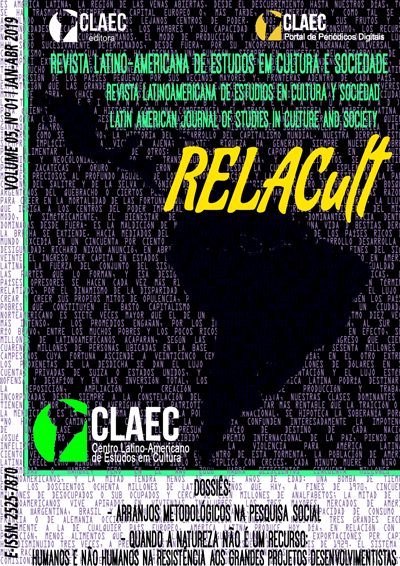Construção Social de Gênero e Busca de Identidade em Persépolis
DOI:
https://doi.org/10.23899/relacult.v5i1.1404Palavras-chave:
gênero, identidade, mulheres, Persépolis, sociedadeResumo
Este texto mostra a necessida de reconhecer que qualquer tipo de repressão vivenciada hoje pelas mulheres, possui raízes patriarcais. Procurando ressaltar estas questões, faz-se uma retomada aos possíveis princípios da estigmatização carregada pela figura da mulher tanto no século XIX, quanto no atual e traz personagens mulheres da graphic novel que dialogam com a desconstrução que se procura no contemporâneo. A análise dessas personagens do quadrinho Persépolis, evidencia pontos importantes como suas histórias e trajetórias de vida, como cada uma lidou com situações em que foram confrontandas por serem mulheres. Esses posicionamentos debatem-se com pensamentos valiosos de teóricas importantes e estudiosas do “ser mulher” em socieade, tanto nos primórdios da luta pela importância da educação e a busca da existência da mulher como ser autônomo, quanto a assuntos envolvendo o assédio e feminicídio, discutidos atualmente. Estudar Persépolis e suas personagens contribui para a desmistificação do que se criou socialmente a respeito da “feminilidade” da mulher e do seu destino estar atrelado ao matrimônio; submissão e redução do seu “eu” para viver em sociedade.
Referências
BEAUVOIR, Simone. O Segundo Sexo: A Experiência Vivida. Tradução de Sérgio Milliet. São Paulo: Difusão Européia do livro, 1967. Ed. 2ª.
______. O Segundo Sexo: Fatos e Mitos. 4. ed. Tradução: Sérgio Milliet. São Paulo: Difusão Européia do Livro, 1970.
COBRA, Ercília Nogueira. Virgindade Anti-higiênica: Preconceitos e convenções hipócritas. Ed. da Autora, São Paulo, 1924. 127 p.
ELIADE, Mircela, 1907-1986. Dicionário das religiões. Tradução: Ivone Castilho Benedetti. 2. ed. São Paulo: Martins Fontes, 1999.
FRENCH, Marilyn. A Guerra Contra as Mulheres. Tradução: Maria Therezinha M. Cavallari. São Paulo: Best Seller, 1992.
MAHMUD, Abdel Haleem. The Creed of Islam. Translated by Dr. Mahmud Abdel Haleem. World of Islam Festival Trust, 1978.
NEUMANN, M. N. Por detrás dos véus: A mulher muçulmana e as Revoluções Turca e Iraniana. Pap. Polít. Bogotá, Colombia, v. 11, n. 2, p. 761-795, 2006.
SATRAPI, Marjane. Bordados. Tradução: Paulo Werneck – São Paulo: Companhia das Letras, 2010.
______. Persépolis. Tradução: Paulo Werneck. São Paulo: Companhia das Letras, 2007.
WOOLF, Virginia. Um Teto Todo Seu. Tradução: Vera Ribeiro. São Paulo: Nova Fronteira S.A., 1928.
Downloads
Publicado
Edição
Seção
Licença
Autores que publicam nesta revista concordam com os seguintes termos:
a) Os autores mantêm os direitos autorais e concedem à revista o direito de primeira publicação, com o trabalho simultaneamente licenciado sob a Creative Commons Attribution License BY-NC (https://creativecommons.org/licenses/by-nc/4.0/) que permite o compartilhamento do trabalho com reconhecimento da sua autoria e publicação inicial nesta revista.
b) Esta revista proporciona acesso público a todo o seu conteúdo, uma vez que isso permite uma maior visibilidade e alcance dos trabalhos publicados. Para maiores informações sobre esta abordagem, visite Public Knowledge Project, projeto que desenvolveu este sistema para melhorar a qualidade acadêmica e pública da pesquisa, distribuindo o OJS assim como outros softwares de apoio ao sistema de publicação de acesso público a fontes acadêmicas. Os nomes e endereços de e-mail neste site serão usados exclusivamente para os propósitos da revista, não estando disponíveis para outros fins.

